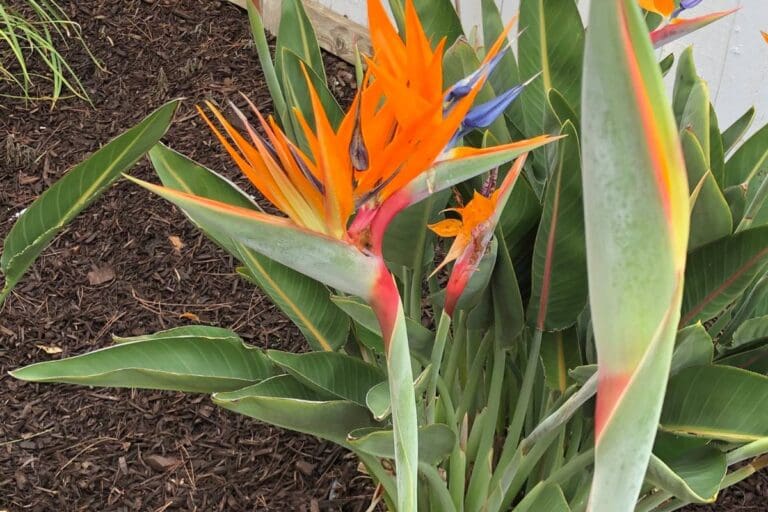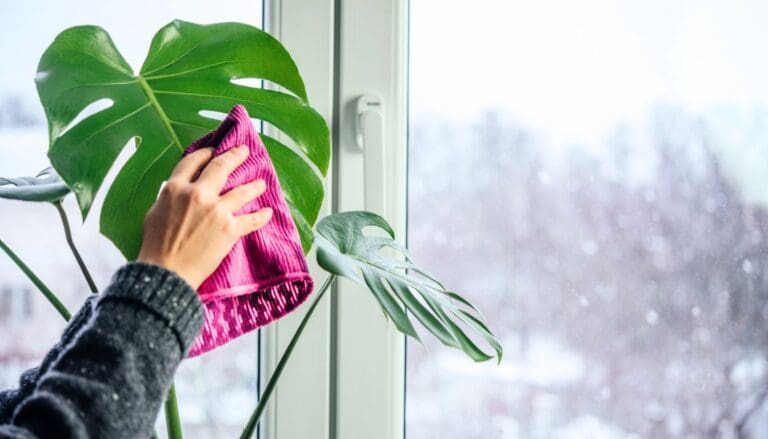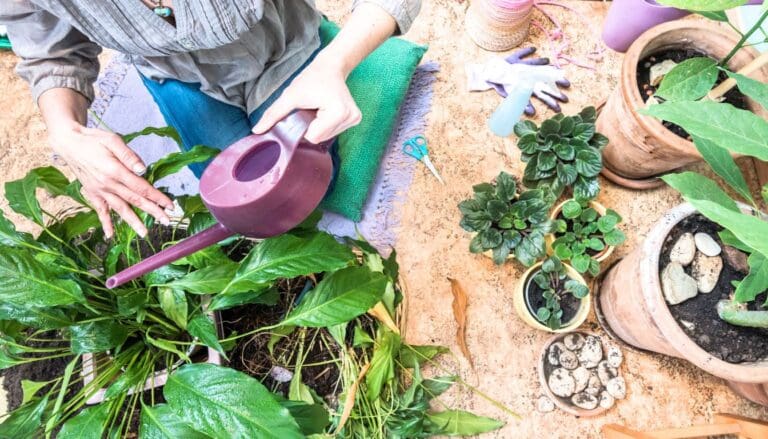10 Tips to Make a Snake Plant Bloom
Snake plants are some of my favorite indoor plants. These tough, low-maintenance beauties can thrive in almost any indoor space, and they look amazing even without flowers.
While snake plants don’t flower often, I can teach you how to create the perfect conditions that encourage your snake plant to produce its lovely white blooms. Getting a snake plant to flower takes some patience and specific care, but the results are worth the effort.
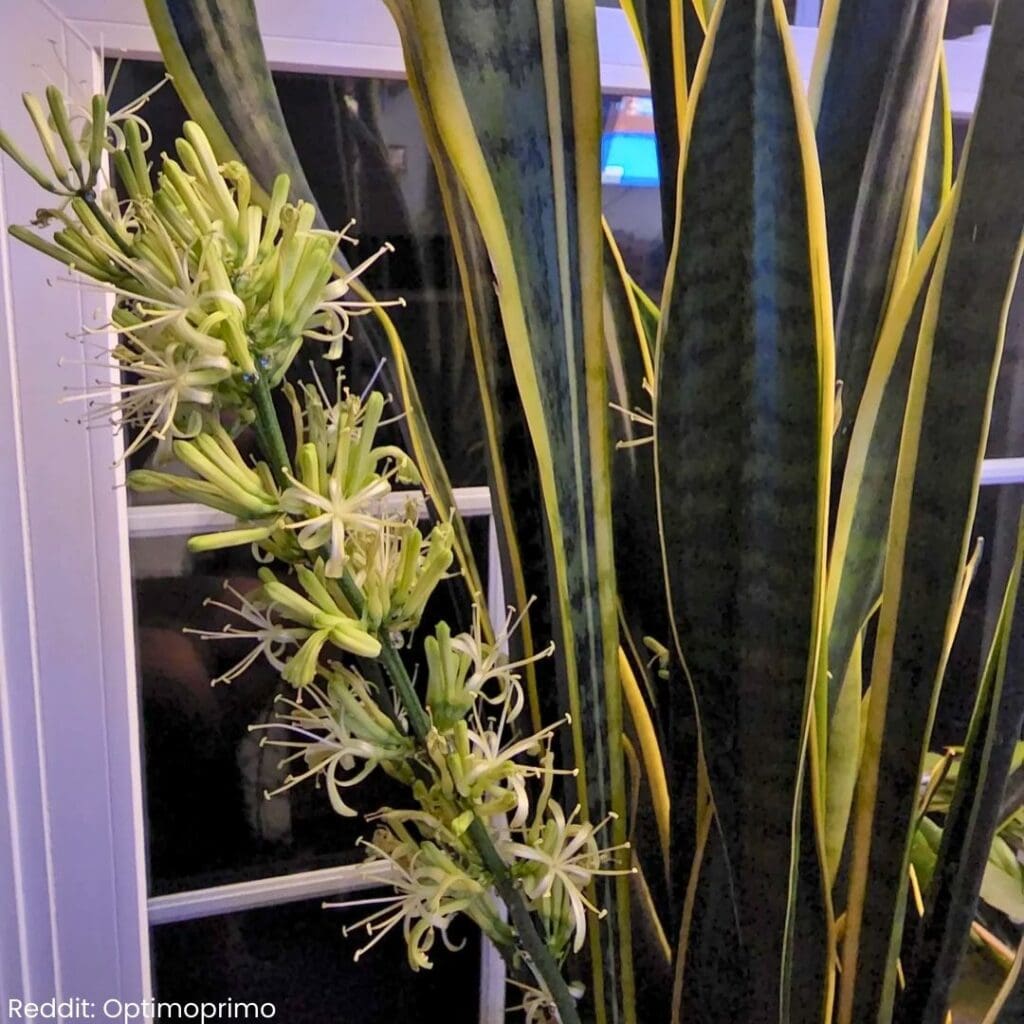
Please note: Simplify Plants is reader-supported. As an Amazon Associate, I earn from qualifying purchases made by our readers with no extra cost added to you all! Some links in the post are affiliate links and I get a commission from purchases made through links in the post.
1) Proper lighting
I’ve found that proper lighting plays a huge role in getting snake plants to bloom. These tough plants need plenty of bright, indirect sunlight to produce their lovely flowers.
From my experience, placing the snake plant near a south or east-facing window gives the best results. The plant should get at least 6 hours of indirect light daily.
I avoid putting my snake plants in direct sun, as this can burn their leaves. A few feet away from a bright window works perfectly. If the leaves start turning yellow, that’s a sign of too much light.
Low light conditions make blooming very unlikely. I’ve noticed that snake plants rarely flower when kept in dark corners or spaces far from windows.
If natural light is limited in your home, I recommend using grow lights for 8-10 hours daily. Position the grow light about 12 inches above the plant for optimal results.
During winter months, I move my snake plants closer to windows to make up for shorter days. This helps maintain the light levels they need to potentially bloom.
2) Consistent watering schedule
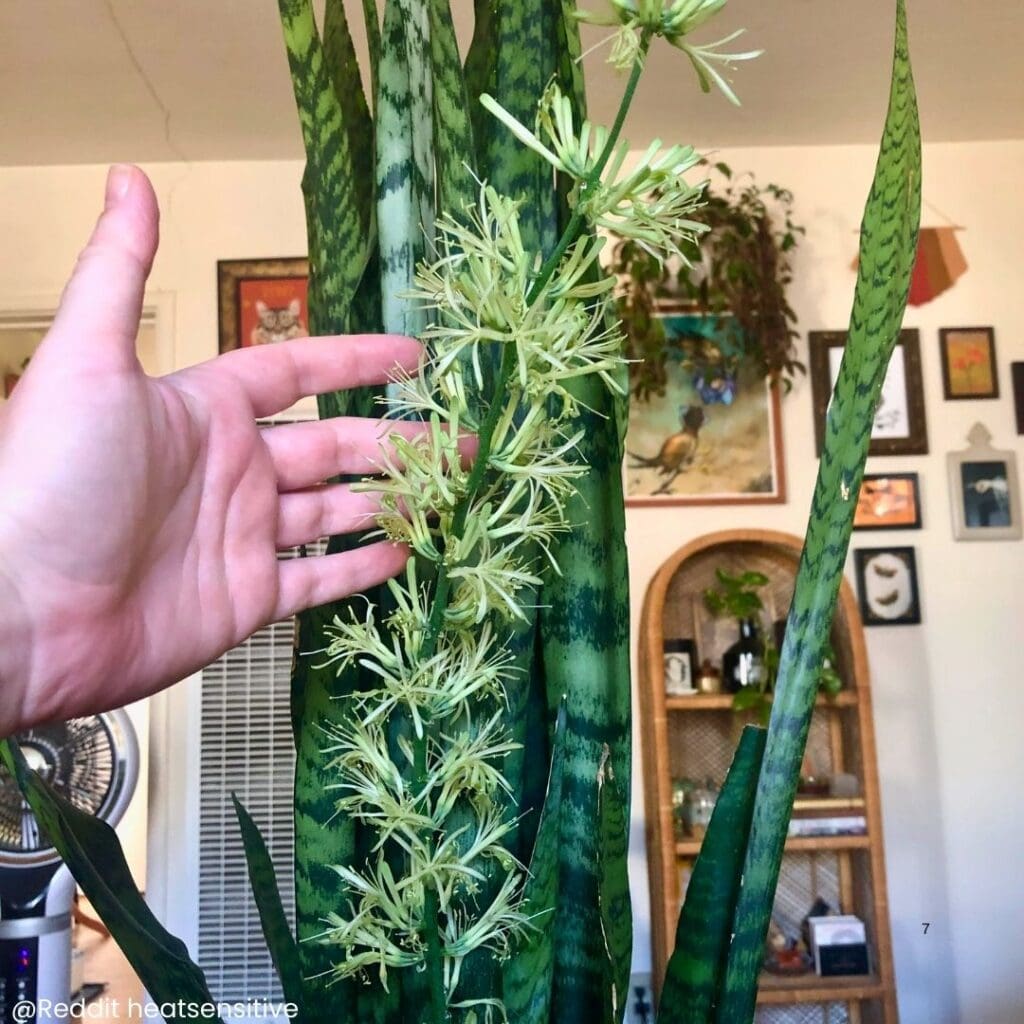
I recommend keeping your snake plant on a regular watering schedule to encourage blooming. The key is not to overwater – these plants prefer their soil to dry out between waterings.
In my experience, watering once every 2-3 weeks works best during the growing season (spring and summer). During winter, I cut back to once every 4-6 weeks since the plant goes into a resting phase.
I always check the soil moisture before watering. I stick my finger about 2 inches deep into the soil – if it feels dry, it’s time to water. If it’s still damp, I wait a few more days.
Good drainage is crucial for snake plants. I make sure the pot has drainage holes and I empty the saucer after watering to prevent root rot. Root rot can stop a snake plant from blooming.
I water thoroughly until it runs out the bottom of the pot, but I never let the plant sit in standing water. This helps create strong roots that support blooming.
When the seasons change, I adjust my watering schedule gradually. Too much change at once can stress the plant and prevent flowering.
3) Use a well-draining soil
I recommend using a light and airy potting mix for snake plants. The perfect mix should have plenty of perlite or coarse sand to help excess water flow through quickly.
You can make your own soil mix by combining regular potting soil with equal parts perlite and coarse sand. This creates lots of air pockets that help prevent water from pooling around the roots.
I’ve found that adding some orchid bark to the mix also works great. It helps create even more drainage while keeping the soil from becoming too compact over time.
Avoid using regular garden soil or heavy potting mixes. These hold too much moisture and can cause root rot in snake plants. They prefer their soil on the drier side.
When I repot my snake plants, I make sure to gently break up any compacted soil around the roots before putting them in fresh mix. This gives the roots room to breathe and grow.
A good test is to water the plant and watch how quickly it drains. If water sits on top for more than a few seconds, the soil mix needs more drainage materials added to it.
4) Appropriate pot size
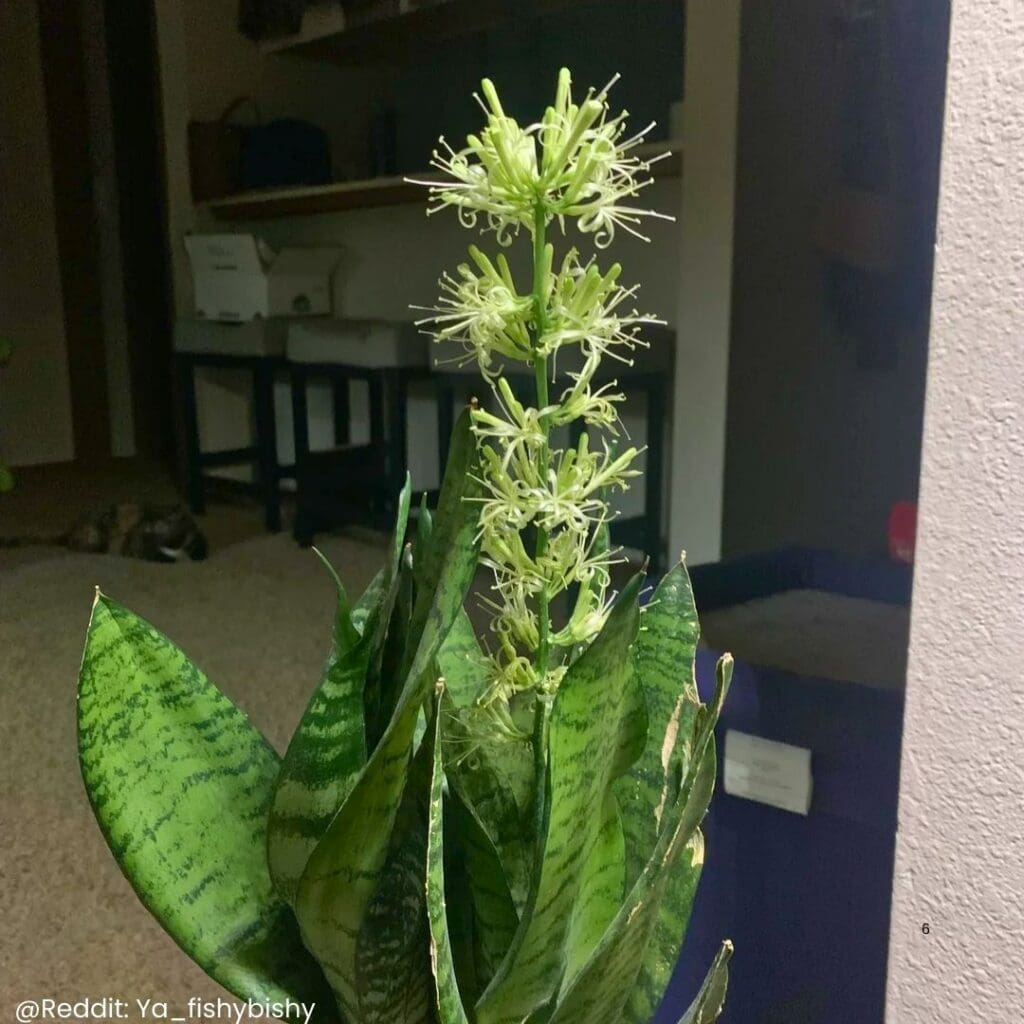
I’ve found that choosing the right pot size is crucial for making snake plants bloom. Snake plants prefer to be slightly root-bound, which means keeping them in a snug container.
I recommend using a pot that’s only 1-2 inches wider than the plant’s root ball. Too much space can cause the roots to spread out instead of growing dense, which reduces the chances of blooming.
The best pot size depends on your plant’s current size. For a small snake plant, I use a 4-6 inch pot. Medium-sized plants do well in 6-8 inch containers, while larger ones need 8-10 inch pots.
I always make sure the pot has drainage holes at the bottom. A well-draining pot helps prevent root rot and creates the right conditions for flowering.
When I notice roots growing out of the drainage holes or the plant becoming top-heavy, I know it’s time to move up one pot size. I don’t rush to repot since snake plants bloom better when they’re slightly crowded.
I’ve learned that terra cotta pots work really well for snake plants. They allow excess moisture to evaporate through their walls, which these plants love.
5) Regular fertilization
I recommend feeding your snake plant with a balanced liquid fertilizer every 4-6 weeks during the growing season (spring and summer). A 10-10-10 NPK ratio works great for promoting blooms.
Don’t fertilize in fall or winter when the plant’s growth naturally slows down. Too much fertilizer during dormancy can harm your snake plant and prevent flowering.
I always dilute the fertilizer to half strength before applying it. Snake plants are light feeders, and too much fertilizer can burn their roots. A gentle approach works best.
Make sure to apply the fertilizer only when the soil is moist. I never feed my snake plant when the soil is completely dry, as this can damage the roots.
Watch for signs of over-fertilization like brown leaf tips or yellowing leaves. If you notice these symptoms, I suggest flushing the soil with plain water and reducing the fertilizer amount.
I’ve found that organic fertilizers like worm castings or fish emulsion work well too. These release nutrients slowly and are less likely to cause fertilizer burn.
6) Prune dead leaves
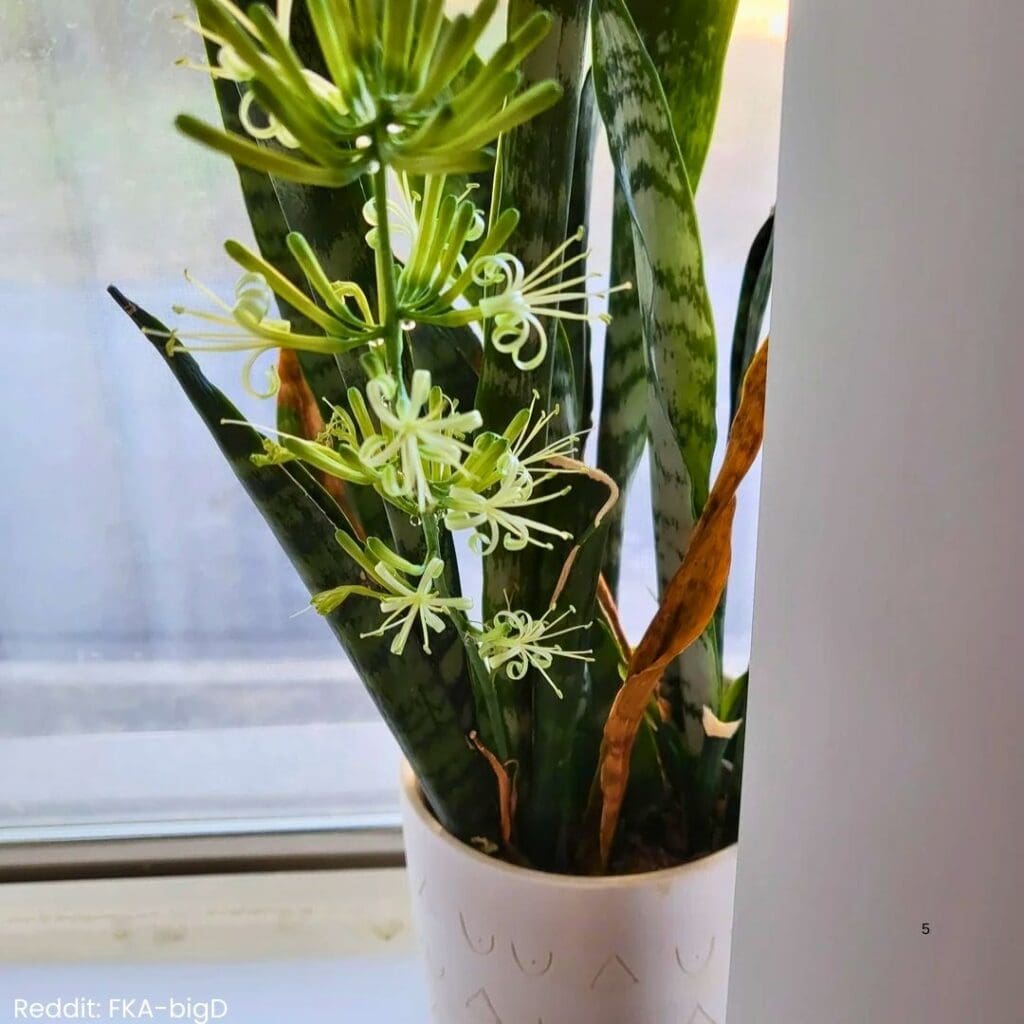
I recommend checking your snake plant regularly for any dead, yellow, or brown leaves. These damaged leaves won’t help your plant bloom and can actually hurt its growth.
Remove dead leaves by cutting them off at the base, as close to the soil as possible. I always use clean, sharp scissors or pruning shears to make clean cuts and avoid damaging the healthy parts.
Removing dead leaves helps direct energy to new growth and blooming. I make sure to wipe my cutting tools with rubbing alcohol between cuts to prevent spreading any plant diseases.
Sometimes leaves can look partially dead or yellow. In these cases, I trim off just the damaged portions while leaving the healthy green parts intact. This keeps the plant looking neat and supports better flowering.
Don’t remove more than 20% of the leaves at once. Taking away too many leaves can stress the plant and make it less likely to produce flowers.
I also take this time to look for any signs of pests or disease while I’m pruning. Catching problems early makes it easier to keep the plant healthy enough to bloom.
7) Optimal temperature maintenance
I’ve found that snake plants need the right temperature to bloom. The ideal temperature range is between 70-90°F (21-32°C) during the day.
At night, I let the temperature drop slightly to 60-65°F (15-18°C). This temperature change helps trigger blooming in snake plants.
I make sure to keep my snake plant away from cold drafts near windows and doors. Cold air can shock the plant and prevent flowering.
The plant also doesn’t like extreme heat. I keep it away from heating vents and direct sun, which can make the air too hot and dry.
In winter, I move my snake plant to a warmer spot in the house. Cold temperatures below 50°F (10°C) can damage the plant and stop it from producing flowers.
I use a simple thermometer near my plant to track the temperature. This helps me know when I need to adjust its location for better growing conditions.
8) Seasonal dormancy

Snake plants need a period of rest during winter months, just like many other houseplants. I’ve found that giving them a break helps trigger blooming when spring arrives.
During winter, I reduce watering by about half. My snake plant only needs water when the soil feels completely dry about 2 inches deep. This natural rest period is essential for future blooming.
I keep my snake plant in a cooler spot during winter, around 60-65°F (15-18°C). The lower temperatures and reduced watering signal to the plant that it’s time to rest.
I stop fertilizing completely in winter. The plant doesn’t need extra nutrients during its dormant phase, and too much fertilizer can actually harm it.
When spring comes, I gradually increase watering and return to normal care. This transition from dormancy to active growth often triggers the blooming process in healthy snake plants.
I make sure to maintain bright indirect light even during dormancy. While the plant needs less water and fertilizer, good lighting helps it stay healthy through winter.
9) Humidity control
I’ve found that snake plants bloom best when humidity levels stay between 40-50%. These desert-native plants don’t need high humidity to thrive.
Too much moisture in the air can actually stop your snake plant from flowering. I make sure to keep my snake plant away from humidifiers and steamy bathrooms.
If your home has high humidity, you can use a dehumidifier near your plant. I also add a fan for better air circulation, which helps prevent moisture from settling on the leaves.
In dry winter months, the natural indoor humidity is usually perfect for snake plants. There’s no need to mist the leaves or use humidity trays – these can cause more harm than good.
I check my humidity levels with a simple meter from the garden store. When the reading stays in the right range, my snake plants are more likely to produce those lovely white blooms.
Remember to place your snake plant away from air vents and radiators. These spots can create sudden humidity changes that might stress the plant and prevent flowering.
10) Pest management

I’ve found that keeping snake plants pest-free is key to encouraging blooms. Healthy plants are more likely to flower, and pests can drain their energy.
Spider mites, mealybugs, and fungus gnats are the most common pests I see on snake plants. I check my plants weekly by looking under the leaves and around the soil surface for any signs of trouble.
I use neem oil spray as my go-to solution when I spot pests. It’s natural and effective. I mix 2 teaspoons of neem oil with water in a spray bottle and apply it every 7-10 days until the pests are gone.
Good air circulation helps prevent pest problems. I make sure to space my plants properly and use a small fan if needed. This makes it harder for pests to settle in.
When I bring new plants home, I always quarantine them for 2 weeks. This protects my existing snake plants from potential pest problems. I keep the new plants in a separate room during this time.
I also wipe the leaves with a damp cloth monthly. This removes dust and makes it easier to spot any early signs of pests. Clean leaves are better at photosynthesis too, which helps with blooming.
Understanding Snake Plant Blooms
Snake plant flowers are rare but beautiful white or cream-colored blooms that grow on tall stalks. I’ve found that these sweet-smelling flowers can appear when the plant gets just the right care.
Botanical Characteristics
I can tell you that snake plant flowers grow in clusters on long flower spikes that rise above the leaves. The blooms are tubular in shape and about 1 inch long. They release a light, sweet fragrance that’s strongest at night.
The flowers start as small buds and open into delicate star-shaped blooms. Most snake plant varieties produce creamy white or light green flowers.
Each flower spike can hold dozens of small blossoms that open gradually over several weeks. The blooms tend to be more common on mature plants that are at least 3-4 years old.
Natural Blooming Cycle
Snake plants typically bloom in spring or late summer. I’ve noticed they need specific conditions to produce flowers – like being slightly root-bound and getting bright indirect light.
The blooming period usually lasts 2-3 weeks. Each flower opens for just a few days before fading.
The plant won’t bloom every year. In fact, some snake plants may go many years between flowering cycles. This irregular blooming pattern is totally normal and doesn’t mean there’s anything wrong with your plant.
After blooming, the flower stalk will naturally die back. I simply cut it off near the base once it turns brown.

Creating Optimal Conditions
Your snake plant needs specific care and conditions to produce its beautiful blooms. I’ve learned that the right mix of light, temperature, soil, and water makes all the difference.
Light and Temperature Requirements
I recommend placing your snake plant in bright, indirect sunlight for 6-8 hours daily. A spot near an east or west-facing window works great.
Snake plants bloom best when kept between 70-90°F (21-32°C). I’ve found they’re happiest in warm rooms with good air circulation.
In winter, keep them away from cold drafts and windows. They can handle temperatures as low as 50°F (10°C), but cold stress will prevent blooming.
Pro tip: During summer, I move my snake plants outdoors to a shaded patio. The natural light cycles often trigger blooming.
Soil and Watering Guidelines
Use well-draining soil mixed with 30% sand or perlite. This prevents root rot and creates ideal growing conditions.
I water my snake plants only when the top 2 inches of soil feel completely dry. In spring and summer, this means watering every 2-3 weeks.
Reduce watering in winter to once every 4-6 weeks. Too much water will stop your plant from blooming.
The pot needs good drainage holes. I use a terracotta pot because it helps excess moisture evaporate through its walls.
Important: Never let your snake plant sit in standing water. Root health is key for blooming.
Frequently Asked Questions
Snake plant flowers add beauty and interest to these already striking plants. Let me share what I know about getting these stunning blooms.
How can I encourage my snake plant to flower indoors?
I recommend placing your snake plant in bright, indirect sunlight for 6-8 hours daily. This mimics their natural habitat and boosts flowering chances.
A consistent watering schedule is key. I water mine only when the top 2 inches of soil feels dry.
Using a well-draining potting mix prevents root rot and creates the right conditions for blooming.
What are the signs that a snake plant is about to bloom?
I look for a tall flower stalk emerging from the center of the plant. It grows quickly and can reach up to 3 feet tall.
The stalk will develop small, tight buds that look like tiny bells. These usually appear in spring or early summer.
Are there any benefits associated with snake plant flowers?
The sweet fragrance from snake plant flowers can fill a room, especially in the evening. Many people enjoy this natural air freshener.
These flowers attract beneficial pollinators if your plant is outdoors during blooming season.
What should I do when I notice my snake plant is starting to flower?
I make sure to keep the plant stable and undisturbed while the flower stalk grows.
Maintain regular care but avoid moving the plant, as this can stress it and affect blooming.
Can the smell of a snake plant flower indicate its health?
A sweet, pleasant scent means your plant is healthy and the flowers are developing normally.
If you notice any unusual or unpleasant smells, check the plant for signs of disease or pest problems.
What do snake plant flowers represent or symbolize?
Snake plant flowers symbolize protection and good fortune in many cultures.
In feng shui practices, these blooms are believed to bring positive energy into your space.
The flowers remind me of resilience since they only appear when the plant is thriving in ideal conditions.
Recommended Garden Supplies
| Product Image | Our Recommended Gardening Supplies | Check Offers! |
|---|---|---|
Top Top
Top
Top
Top
Top
Top
Top
Top | rePotme Houseplant and Tropical Classic Potting Soil Mix | Check Offer On Amazon |
 Top
Top
Top
Top
Top
Top
Top
Top | Espoma Organic Indoor Plant Food | Check Offer On Amazon |
 Top
Top
Top
Top
Top
Top
Top
Top | GooingTop LED Grow Light 6000K Full Spectrum Clip Plant Growing Lamp | Check Offer On Amazon |
 Top
Top
Top
Top
Top
Top
Top
Top | Soil Moisture Meter | Check Offer On Amazon |
 Top
Top
Top
Top
Top
Top
Top
Top | Govee Hygrometer Thermometer, Bluetooth Enabled! | Check Offer On Amazon |
 Top
Top | LEVOIT Humidifiers for Large Room(Best For Plants) | Check Offer On Amazon |
 Top
Top
Top
Top
Top
Top
Top
Top | Upgraded DIY Automatic Drip Irrigation Kit, 15 Potted Houseplants Support | Check Offer On Amazon |
 Top
Top
Top
Top
Top
Top
Top
Top | Stainless Steel Heavy Duty Gardening Tool Set | Check Offer On Amazon |
 Top
Top
Top
Top
Top
Top
Top
Top | Bonide Insecticidal Soap | Check Offer On Amazon |
 Top
Top
Top
Top
Top
Top
Top
Top | Bonide 32 oz Spray Neem Oil for Organic Gardening | Check Offer On Amazon |
 Top
Top
Top
Top
Top
Top
Top
Top | Garden Safe Fungicide | Check Offer On Amazon |



